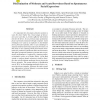Free Online Productivity Tools
i2Speak
i2Symbol
i2OCR
iTex2Img
iWeb2Print
iWeb2Shot
i2Type
iPdf2Split
iPdf2Merge
i2Bopomofo
i2Arabic
i2Style
i2Image
i2PDF
iLatex2Rtf
Sci2ools
94
Voted
ICPR
2010
IEEE
2010
IEEE
Discrimination of Moderate and Acute Drowsiness Based on Spontaneous Facial Expressions
It is important for drowsiness detection systems to warn the driver before the critical stages of drowsiness arise and thus to provide sufficient intervention time for the driver. In our previous study, spontaneous facial expressions measured through computer vision techniques were used as an indicator to discriminate drowsy from alert episodes. Here we are extending it to separate moderate drowsiness and acute drowsiness. In this study we are exploring which facial muscle movements are predictive of moderate and acute drowsiness. The effect of temporal dynamics of action units on prediction performances is explored by capturing temporal dynamics with a set of Gabor Filters. In the final system we perform feature selection to build a classifier that can discriminate moderate drowsy from acute drowsy episodes. The system achieves a classification rate of .96 A’ in discriminating moderately drowsy versus acute drowsy episodes. Moreover the study reveals new information in facial b...
| Added | 13 May 2010 |
| Updated | 13 May 2010 |
| Type | Conference |
| Year | 2010 |
| Where | ICPR |
| Authors | Esra Vural, Marian Stewart Bartlett, Gwen Littlewort, Mujdat Cetin, Aytul Ercil, Javier Movellan |
Comments (0)

